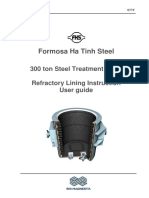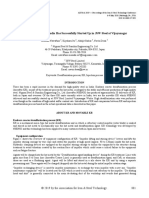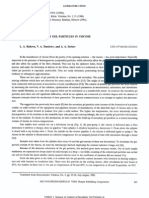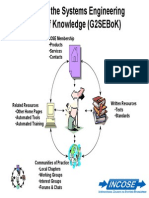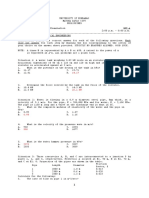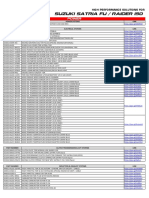Carbon Pick-Up IF Steels PDF
Carbon Pick-Up IF Steels PDF
Uploaded by
Anonymous jYdzzw6Copyright:
Available Formats
Carbon Pick-Up IF Steels PDF
Carbon Pick-Up IF Steels PDF
Uploaded by
Anonymous jYdzzw6Original Title
Copyright
Available Formats
Share this document
Did you find this document useful?
Is this content inappropriate?
Copyright:
Available Formats
Carbon Pick-Up IF Steels PDF
Carbon Pick-Up IF Steels PDF
Uploaded by
Anonymous jYdzzw6Copyright:
Available Formats
Content (wt%)
Carbon and Silicon
Pickup of Soaking time (min)
Relationship between (▲) carbon content and (G) silicon content
Interstitial-Free with soaking time under vacuum.
Steel from Al2O3–SiC
Refractories Pressure (Pa)
Carbon and silicon content of steel
samples heated in Al2O3–SiC crucibles
increased with soaking time and was
controlled by an impregnation–
dissolution mechanism.
Time (min)
Guozhi Ruan, Nan Li and Zhihui Zhang
Pressure variation of inner furnace with time (steel melt marked as
0 min).
Clean steel becomes more important with increased demands for high-quality steel. Ultralow carbon con-
tent and few inclusions are required for some steel.1 Low carbon content can be realized by refining. However,
molten steel may be recarburized by carbon-containing refractories after it is refined.2,3 Heat treatment and
carbon content of as well as antioxidant addition to refractories greatly influence the pickup of carbon by
molten steel.4,5
Bannenberg et al.6 as well as the current authors and their colleagues7–9 have reported that MgO–C and
Al2O3–C refractories cause carbon pickup by molten steel. Therefore, novel high-performance refractories
need to be substituted for carbon-containing refractories. As a result, Al2O3–SiC refractories have received
extensive study.
The Experiment
Raw materials used were white fused alumina (WFA) and SiC. Phenol formaldehyde resin was used as
binder. Al2O3–SiC crucibles with a SiC content of 15 wt% were fabricated using cold isostatic pressing at
~200 MPa. The crucibles, made by mixtures, were heated at 280°C for 24 h. The crucibles were dried, 6 kg
of interstitial-free (IF) steel was added, crucibles and steel were placed in a vacuum induction furnace and the
system then was placed under vacuum.
The IF steel composition—which was provided by Baoshan Iron and Steel Co. Ltd.—and its carbon con-
tent were determined using high-frequency combustion infrared absorption. Heating of the crucibles began
when the pressure in the furnace was ~10 Pa. The pressure in the furnace first increased then slightly
American Ceramic Society Bulletin, Vol. 85, No. 10 9101
Carbon and Silicon Pickup
decreased (usually) with increased temperature. The pres-
sure varied because of furnace-lining vaporization and
molten-steel overflow caused by boiling until the experi-
ment was halted when the IF steel melted under vacuum
conditions. Thereafter, the furnace was filled with argon and
the pressure was controlled.
The Al2O3–SiC crucibles that contained IF steel were
Si/C
heated at 1600°C for 2 h in a vacuum induction furnace.
The first sample of molten steel was removed via a quartz
pipe when the molten steel reached 1600°C. This time was
marked as 0 min, and steel samples also were taken at 30, 60,
90 and 120 min. Carbon content of steel melt samples was
determined using high-frequency combustion infrared
absorption (Model CS-444LS, LECO Co., St. Joseph,
Mich.). The refractory after heating was investigated using
Soaking time (min)
electron probe microanalysis (EPMA; Model ISIS, Oxford
Instruments, Concord, Mass.) with energy-dispersive spec- Relationship between the silicon-to-carbon mole ratio pick-
troscopy (EDS; Model JAX-8800R, JEOL, Tokyo). up with soaking time.
Carbon and Silicon Content
The relationship between steel carbon and silicon content and soaking time
at 1600°C in an Al2O3–SiC crucible under vacuum conditions was plotted. The
values used were the average of three experiments. The relationship between the
silicon-to-carbon mole ratio picked up by the molten steel and the soaking time
was plotted. The amount of silicon and carbon as well as the silicon-to-carbon
mole ratio in the molten steel increased with increased soaking time. Before the
first sample was evaluated, the molten steel had picked up a quantity of carbon
and silicon from the Al2O3–SiC refractory crucible.
Composition of Raw Materials
The steel melt pickup of carbon and silicon
from Al2O3–SiC refractories was controlled by an
impregnation–dissolution mechanism.10,11 When
White fused
steel melts contacted SiC, the reaction SiC(s) = Sketch of equipment used in present
Oxide alumina (wt%) SiC (wt%)
C + Si occurred, and the steel melts picked up experiments.
Al2O3 99.30 0.41
equal molar amounts of silicon and carbon.
SiO2 0.22 0.53
CaO 0.03 0.05
Silicon oxidation is preferred to carbon oxidation in steel melts,12 and there
MgO 0.02 0.02 is little oxygen in steel melts and in refractory pores.13,14 Therefore, when the
K 2O 0.025 0.02 reaction Si + O = SiO(g) occurs, the mole amount of carbon pickup in the steel
Na2O 0.021 0.02 melt is greater than that of silicon. When the soaking time increases, the O in
Fe2O3 0.30 0.17 the steel melt is exhausted, the degree of silicon pickup increases and the car-
TiO2 0.012 0.02 bon to silicon mole ratio pickup in the steel melt decreases. The weight
amount of carbon pickup from refractories is much less that of silicon because
the molar weight of silicon is greater than that of carbon. I
SiC 97.90
LOI 0.40
Composition of IF Steel
Acknowledgment
The authors would like to thank the Education Dept. of Hubei Province
Component Composition (ppm) Government for financial support and E. Cai for fabricating the crucibles.
Carbon 20
Silicon 300 About the Authors
Manganese 1200
Phosphorus 100 Guozhi Ruan and Zhihui Zhang are researchers with Hubei Province Key
Sulfur 78 Lab of Refractories and Ceramics, Wuhan University of Science and
Aluminum 450 Technology, Wuhan, Hubei, China, and are faculty members of Shandong
Nitrogen 34 University of Science and Technology, Qingdao, Shandong, China. Nan Li
Titanium 730 is a researcher with Hubei Province Key Lab of Refractories and Ceramics.
Oxygen 15
Corres-pondence should be addressed to Guozhi Ruan at Shandong
Iron Balance
University of Science and Technology.
9102 American Ceramic Society Bulletin, Vol. 85, No. 10
Carbon and Silicon Pickup
References
1H. Jacobi, “Metallurgy and Materials Technology of High-Purity Steels,” Stahl Eisen, 11 [1] 45–56 (1994).
2W.E. Lee and S. Zhang, “Carbon-Containing Castables: Current Status and Future Prospects,” Int. Mater. Rev., 44,
77–105 (1999).
3J.Lehmann and M. Boher, “Metal/Refractories Interactions: A Thermodyna-mic Approach”; pp. 23–27 in UNITECR’01
Proceedings (Cancun, Mexico, 2001).
4W. Lin, “Decarbonisation Behaviour of Graphite-Containing Refractories by Molten Steel,” Taikabutsu Overseas, 19
[4] 15–24 (1999).
5J.
Potschke, K. Beimdiek and M. Ollig, “Reaction between MgO–C Bricks and Steel Melts”; pp. 166–69 in UNITECR’99
Proceedings (Berlin, Sept. 1999).
6N. Bannenberg, “Demands on Refractory Material and Steel for Clean Steel Production”; pp. 37–59 in UNITECR’95
Proceedings, Vol. 1 (Kyoto, Nov. 1995).
7G.Z. Ruan and N. Li, “Carbon Pickup of Interstitial Free Steel from Al2O3–C Refractories,” Ironmaking Steelmaking, 31
[4] 342–44 (2004).
8G.Z. Ruan and N. Li, “Research on Carbon Pick-Up of IF Steel Liquid by Al2O3–C Refractory” (in Chin.), Naihuo
Cailiao, 38 [6] 399–401 (2004).
9G.Z. Ruan and N. Li, “Progress in Research on Reaction between MgO–C Refractory and Liquid Steel” (in Chin.),
Mater. Rev., 17 [7] 26–29 (2003).
10G.Z.
Ruan and N. Li, “Effects of Antioxidant in Al2O3–C Refractories on Carbon Pickup of Ultra Low Carbon Steel,”
Am. Ceram. Soc. Bull., 84 [10] (2005) (web).
11H.Soulard, J. Lehmann, M. Boher, M.C. Kaerle and C. Gatellier, “Interaction Mechanisms between MgO–C and
Al-Killed Steels”; pp. 301–303 in UNITECR’99 Proceedings (Berlin, Sept. 1999).
12X. Huang, Principles of Ironmaking and Steelmaking (in Chin.); pp. 303–305. Metallurgical Industry Publishing House,
Beijing, 1997.
13N. Li, L.H. Li and Y.W. Wei, “Effect of Microsilica in MgO-Based Castables on Oxygen Content of Interstitial Free
Steel,” Br. Ceram. Trans., 102 [4] 175–79 (2003).
14N. Li, “Influences of Calcium Aluminate Cement in Magnesia Castable on Total Oxygen Content of Interstitial Free
Steel,” Br. Ceram. Trans., 103 [4] 139–42 (2004).
American Ceramic Society Bulletin, Vol. 85, No. 10 9103
You might also like
- Draft Executive Summary of Beekay SteelsDocument6 pagesDraft Executive Summary of Beekay SteelsSuryakanta PradhanNo ratings yet
- BS 8411-2019Document32 pagesBS 8411-2019Elif OztrkNo ratings yet
- 4 Seven Refractories Power Plants and Incinerators 2019 WEB 1Document15 pages4 Seven Refractories Power Plants and Incinerators 2019 WEB 1Kristanto WahyudiNo ratings yet
- Effects of Lithium Carbonate Additives in High Alumina CastableDocument13 pagesEffects of Lithium Carbonate Additives in High Alumina CastableIan AjaNo ratings yet
- Optimization of Tap Hole Concept in JSPL BFDocument9 pagesOptimization of Tap Hole Concept in JSPL BFSaumit PalNo ratings yet
- BF Runner Mix 20 MT VesuviusDocument3 pagesBF Runner Mix 20 MT VesuviusSaumit PalNo ratings yet
- A Critical Analysis ON Tap Hole by Abhik ChakrabortyDocument24 pagesA Critical Analysis ON Tap Hole by Abhik Chakrabortyravish8888No ratings yet
- Slide Gate System DevelopmentDocument14 pagesSlide Gate System DevelopmentA.S.M. Mosayeb RafiNo ratings yet
- Stainless Steel Production by IfDocument4 pagesStainless Steel Production by IfAbhinav TiwariNo ratings yet
- Steel Detailing Guide-2Document108 pagesSteel Detailing Guide-2Travel LoverNo ratings yet
- Blast Furnace Trough CastablesDocument104 pagesBlast Furnace Trough CastablesPriyabrataTaraiNo ratings yet
- Restoration of Stamp Charge Battery Health Through Operational Excellence at Tata Steel, IndiaDocument8 pagesRestoration of Stamp Charge Battery Health Through Operational Excellence at Tata Steel, IndiaKamal JoubNo ratings yet
- 7B-4 Charging HM in EAF's - Reducing Cost PDFDocument16 pages7B-4 Charging HM in EAF's - Reducing Cost PDFChristiani Hera TangkealloNo ratings yet
- Optimization of Aluminum Deoxidation Practice in The Ladle FurnaceDocument18 pagesOptimization of Aluminum Deoxidation Practice in The Ladle FurnaceKanan SahooNo ratings yet
- Paper On Casthouse Refractories - Tata SteelDocument5 pagesPaper On Casthouse Refractories - Tata SteelSaumit PalNo ratings yet
- Tap Hole ClaysDocument1 pageTap Hole ClaysNishant BandaruNo ratings yet
- Dri Update May - 2021Document31 pagesDri Update May - 2021Vivek RanganathanNo ratings yet
- Alternative To Fluorspar As A Fluxing Agent in Ladle Furnace During Secondary Steel Refining ProcessDocument54 pagesAlternative To Fluorspar As A Fluxing Agent in Ladle Furnace During Secondary Steel Refining ProcessPrashant ChoudharyNo ratings yet
- IREFCON 2014 (Trough Castable For Blast Furnace) 61c034b365Document5 pagesIREFCON 2014 (Trough Castable For Blast Furnace) 61c034b365PriyabrataTaraiNo ratings yet
- A Study On Indian Refractories IndustryDocument10 pagesA Study On Indian Refractories IndustryMahesh BuffettNo ratings yet
- Blast Furnace DescriptionDocument26 pagesBlast Furnace DescriptionMoganna Gowda100% (1)
- Refractories Basic RefractoriesDocument11 pagesRefractories Basic Refractoriesanjali sharmaNo ratings yet
- Presentation On Tap Hole Management Practice by A. ChakrabortyDocument22 pagesPresentation On Tap Hole Management Practice by A. Chakrabortyravish8888No ratings yet
- VSB Blast Furnace Operation With High Productivity Using High Oxygen EnrichmentDocument14 pagesVSB Blast Furnace Operation With High Productivity Using High Oxygen EnrichmentJJ100% (1)
- RHI MagnesitaDocument2 pagesRHI MagnesitaMauricio MessiNo ratings yet
- Almatis - Andus Buhr - TrendsRefractoriesCleanSteelTechnology - LitcorrectionDocument15 pagesAlmatis - Andus Buhr - TrendsRefractoriesCleanSteelTechnology - LitcorrectionSaptarshi SenguptaNo ratings yet
- Chapter3-Overview On Carbon Bond RefractoriesDocument18 pagesChapter3-Overview On Carbon Bond RefractoriesNguyễn ChungNo ratings yet
- Innovative Top Combustion Hot Stoves of Kalugin Design For High Technical and Environmental PerformanceDocument10 pagesInnovative Top Combustion Hot Stoves of Kalugin Design For High Technical and Environmental PerformanceJJNo ratings yet
- How's Steel Manufactured?: Raw Materials For IronmakingDocument6 pagesHow's Steel Manufactured?: Raw Materials For IronmakingUpendra93No ratings yet
- Steel PlantDocument68 pagesSteel PlantRohithNo ratings yet
- Refractory For EAF-GuideDocument4 pagesRefractory For EAF-GuideJayasimha TammineniNo ratings yet
- FHS Ladle Installation Manual Incld OPI - 10.5.2018Document28 pagesFHS Ladle Installation Manual Incld OPI - 10.5.2018Nguyễn ChungNo ratings yet
- Nippon Steel & Sumikin Engineering's Blast FurnaceDocument4 pagesNippon Steel & Sumikin Engineering's Blast Furnacekalai100% (1)
- Tap Hole Clay - VesuviusDocument26 pagesTap Hole Clay - VesuviusSaumit Pal100% (1)
- First Movable KR in India Has Successfully Started Up in JSW Steel at VijayanagarDocument10 pagesFirst Movable KR in India Has Successfully Started Up in JSW Steel at VijayanagarJJNo ratings yet
- CVS General PresentationDocument63 pagesCVS General PresentationmetudgnNo ratings yet
- Progress and Perspective of Refractory Technology: Technical ReviewDocument5 pagesProgress and Perspective of Refractory Technology: Technical ReviewemregnesNo ratings yet
- The Effect of Temperature Upon The Setting Behaviour of Refractory Calcium Aluminate CementsDocument10 pagesThe Effect of Temperature Upon The Setting Behaviour of Refractory Calcium Aluminate CementsLenia LuciaNo ratings yet
- Iron Making MM 321: Course Teacher: Dr. Natraj YedlaDocument55 pagesIron Making MM 321: Course Teacher: Dr. Natraj YedlaS Tejanath ReddyNo ratings yet
- CISDI's Blast Furnace Overhaul Technology and PracticeDocument6 pagesCISDI's Blast Furnace Overhaul Technology and PracticeJJNo ratings yet
- Good Ladle Preheating PracticesDocument9 pagesGood Ladle Preheating PracticessriNo ratings yet
- Lump Ore Characteristics and Their Impact On Blast Furnace OperationDocument7 pagesLump Ore Characteristics and Their Impact On Blast Furnace Operationalvaroaac4100% (1)
- A Thesis Submitted in The Partial Fulfillment of The Requirements For The Degree of Bachelor of TechnologyDocument53 pagesA Thesis Submitted in The Partial Fulfillment of The Requirements For The Degree of Bachelor of TechnologyMagesh KumarNo ratings yet
- 15 Days Industrial Training Report File: On Sinter & LDP (10/03/2017-24/03/2017)Document21 pages15 Days Industrial Training Report File: On Sinter & LDP (10/03/2017-24/03/2017)Prashant Kumar mishraNo ratings yet
- Corex-BF ComparisonDocument4 pagesCorex-BF ComparisonUmashankar GovindappaNo ratings yet
- Mass Balance Modeling Eaf & Ladle Furnace Turkey PDFDocument8 pagesMass Balance Modeling Eaf & Ladle Furnace Turkey PDFsuveer kumar100% (1)
- Slag Attack Mag CarbDocument12 pagesSlag Attack Mag CarbAnindya RoyNo ratings yet
- RHI Bulletin: The Journal of Refractory InnovationsDocument56 pagesRHI Bulletin: The Journal of Refractory InnovationsAmerico VespucioNo ratings yet
- Iron ProductionDocument7 pagesIron ProductionVij_78100% (1)
- Advantage and Disadvantage of Raw MaDocument19 pagesAdvantage and Disadvantage of Raw MaNaelNo ratings yet
- Embr 1 PDFDocument32 pagesEmbr 1 PDFKamod RanjanNo ratings yet
- Blast Furnace BF Refractory Lining PatternDocument5 pagesBlast Furnace BF Refractory Lining PatternSarthakShangariNo ratings yet
- Refractories PDFDocument22 pagesRefractories PDFRinku Singroha (JSHL-QUALITY)No ratings yet
- 4 AodDocument5 pages4 AodSonu MishraNo ratings yet
- SSAB-The Steel Book 2002Document22 pagesSSAB-The Steel Book 2002José Paulo SeoaneNo ratings yet
- Overview - RefractoriesDocument41 pagesOverview - RefractoriesRogerShNo ratings yet
- Electric Arc Furnace: SteelDocument37 pagesElectric Arc Furnace: SteelAristeudesQuintinoNo ratings yet
- Commonly Used Refractory 1: Silica Bricks: TMT619214 Bata Tahan Api Dan Terak 2021Document12 pagesCommonly Used Refractory 1: Silica Bricks: TMT619214 Bata Tahan Api Dan Terak 2021Mugi MaulaNo ratings yet
- Direct Reduced Iron - IspatGuruDocument17 pagesDirect Reduced Iron - IspatGuruSanjeet KumarNo ratings yet
- EAF Refractory Performance at Pacific SteelDocument11 pagesEAF Refractory Performance at Pacific SteelSaragadam DilsriNo ratings yet
- Design and Study of Inset Feed PDFDocument7 pagesDesign and Study of Inset Feed PDFVijaya ShreeNo ratings yet
- Standard Test Method For Determining The Consistency of Refractory Castable Using Ball-In-HandDocument4 pagesStandard Test Method For Determining The Consistency of Refractory Castable Using Ball-In-Handmuhdmsoh100% (1)
- 2016 Motion Equations ReviewDocument2 pages2016 Motion Equations ReviewLeslie RuoNo ratings yet
- Formation of Secondary Gel Particles in ViscoseDocument3 pagesFormation of Secondary Gel Particles in ViscoseAditya ShrivastavaNo ratings yet
- Journal of Analytical and Applied PyrolysisDocument7 pagesJournal of Analytical and Applied PyrolysisRizka Putri Aprilia StundetionNo ratings yet
- IDFL Test Summary - Air Permeability A4Document1 pageIDFL Test Summary - Air Permeability A4Keith WilsonNo ratings yet
- 32pfl1507 f8 Dfu EspDocument37 pages32pfl1507 f8 Dfu EspZiggyStardusttNo ratings yet
- G2 SEBo KDocument47 pagesG2 SEBo KFábio De Toledo Fontana100% (1)
- VMC1000IIPARTSLISTPL97Document105 pagesVMC1000IIPARTSLISTPL97Nica BogdanNo ratings yet
- N45MNT DS P2g04n004u PDFDocument4 pagesN45MNT DS P2g04n004u PDFSecret64No ratings yet
- Sahara Regenerative Air Dryers 03 2020Document32 pagesSahara Regenerative Air Dryers 03 2020Praveen RajNo ratings yet
- Impes MethodDocument19 pagesImpes MethodVishal balar100% (1)
- Alcohol As An Alternative Fuel in I.C. Engine: A Review: Mayank Chandra Joshi, Mayank Joshi, Sumit Suyal, Anurag BahugunaDocument6 pagesAlcohol As An Alternative Fuel in I.C. Engine: A Review: Mayank Chandra Joshi, Mayank Joshi, Sumit Suyal, Anurag BahugunaerpublicationNo ratings yet
- L&T Ball ValveDocument12 pagesL&T Ball ValvecdsenthilNo ratings yet
- Scilab Programs in Chemical Engineering For BeginnersDocument24 pagesScilab Programs in Chemical Engineering For BeginnersvivekNo ratings yet
- Linux Installation On Virtual Machine (Includes Screenshots)Document18 pagesLinux Installation On Virtual Machine (Includes Screenshots)nikhilbhalwankar1883No ratings yet
- Baz ResumeDocument2 pagesBaz ResumesevendollarbolognaNo ratings yet
- Contempo JoanaDocument8 pagesContempo JoanaJoana Marie Narvarte GamengNo ratings yet
- Extradosed BridgeDocument13 pagesExtradosed BridgeAdithya H.B100% (1)
- 10NK80-Data SheetDocument11 pages10NK80-Data Sheetsensat1onNo ratings yet
- Reactive Power ManagementDocument24 pagesReactive Power Managementabdul wakeelNo ratings yet
- 601Document8 pages601Allan Añavisa Ostique Jr.No ratings yet
- Mid2 Objective PaperDocument2 pagesMid2 Objective PaperChilla DivyaNo ratings yet
- 70cm Collinear AntennaDocument3 pages70cm Collinear AntennaRds Comunicaciones EirlNo ratings yet
- Satria Fu 150Document11 pagesSatria Fu 150Jann Michael TeodoroNo ratings yet
- Multiview ManualDocument10 pagesMultiview ManualAna Odzaklieska Krste SmileskiNo ratings yet
- Flyer Production Logging InstrumentationDocument2 pagesFlyer Production Logging Instrumentationgonzalito777No ratings yet
- DrillingDocument36 pagesDrillingMax LuxNo ratings yet
- Sap Hana OperatorDocument5 pagesSap Hana OperatorraamanNo ratings yet































